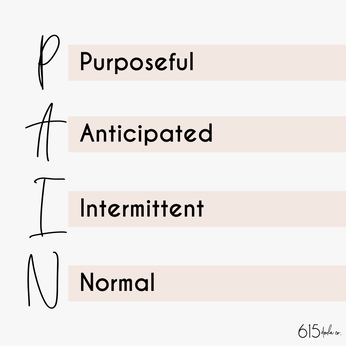 The fear of pain is the most common concern for pregnant people, especially if it is their first birth and they are unsure of what to expect. “How bad is the pain?” or “I don’t know if I will be able to go unmedicated, but I would like to...”, are both common thoughts that I hear from expecting clients who are interested in an unmedicated birth or know that they will experience some labor before an epidural. First things first, it all starts with knowledge. Let’s talk about the sensation or pain you might experience in labor. It helps to memorize this acronym: P: It is not like a charley horse or breaking a bone. It is purposeful. The contraction is doing something very purposeful and productive by opening the cervix, and the uterus muscle is spinning the baby into position, pushing the baby down and out. It is bringing you your baby! A: The sensation is anticipated. Contractions or waves are patterned and they continue to build, so it is not like a scary surprise, but you can sense it building. I: The pain is intermittent, not constant. Unless there is something else going on, you do not feel the sensation of pain in between contractions. These moments in between are nice breaks where you can rest, change positions, communicate, etc. N: The discomfort of labor is normal. The discomfort felt during labor is not cause for alarm, unlike an emergency situation where you break a bone, rupture an appendix, etc. We can normalize the feeling of contractions in labor. Once you have some knowledge around birth, your perception can begin to shift. Many like to re-frame the word “pain” or “contractions”, and prefer to use a word like “waves” or “surges”. I personally call them contractions, but feel that “waves” is a great descriptor because you can feel the contraction building up, peaking, and then falling... like a wave. It then washes away until the next one rolls in. Your only job is to ride the wave, not fight it. I also like to describe it as pure power. It is the kind of power you don’t have to will into existence, instead you have to let it be. It is pretty awe inspiring, and really opens your eyes to what your body can do. The Evidence on Doulas Laboring women report lower pain levels and lower anxiety levels when they are supported by a doula. There is also a decrease in requests for pain medication, and labors are on average shorter with the support of a doula. Pain is a physical reaction. Suffering is an emotional reaction, and can be better understood by education and learning what to expect. Here is a great, short clip from Doula and Childbirth Educator, Penny Simkin, on pain versus suffering. Whether you decide on a medicated or unmedicated birth, it’s important to understand the choices and effects of BOTH options. Below, I have included some popular medications to ease the pain during labor and birth:
The 615 Doula Co Approach As a doula, here are some strategies that I use to reduce pain during labor:
Sources // Evidence Based Birth, National Library of Medicine
0 Comments
Leave a Reply. |
Meet Nicki
Hi, I'm Nicki! I am a Nashville based Doula and founder of 615 Doula Co! My favorite part of working as a Doula is supporting families through the life transitions of pregnancy, birth, and postpartum life. Explore Blog |


